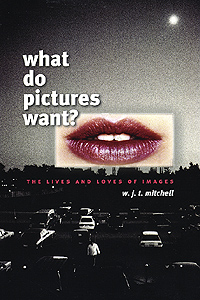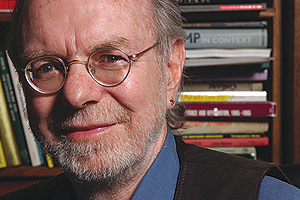Mitchell’s analysis of the ‘lives and loves of images’ receives top Press prize
By Josh SchonwaldNews Office
 | |
At its award ceremony on Monday, April 30, at the University’s Quadrangle Club, the University Press presented the 2006 Gordon J. Laing Prize to W.J.T. Mitchell for his book, What Do Pictures Want: The Lives and Loves of Images.
The award for the book, published in 2005, marks the second time the Gaylord Donnelley Distinguished Service Professor in English Language & Literature, Art History and the College has been named winner of the Laing award. His book Picture Theory: Essays on Verbal and Visual Representation won the 1996 award.
Only two other faculty members have been two-time winners since the inception of the award, said Paula Barker Duffy, Director of the University Press.
Awarded annually to a University faculty member, the Laing Prize has been awarded since 1963 to an author, editor or translator of a book published during the preceding three years that adds the greatest distinction to the University Press. It is named for Laing, who served as general editor for more than 30 years and established its reputation as the premier academic publisher in the United States.
“It’s a great honor, obviously,” said Mitchell, of the award. “And receiving it for a second time, it’s even better.”
In announcing Mitchell’s award, President Zimmer underscored the significance of the prize. The University’s founding president, William Rainey Harper, viewed the University Press to be an intrinsic component of what it meant to be a great research institution, explained Zimmer, “and to me, this award is one very important manifestation of Harper’s view. It links and reaffirms the relationship between the Press and the heart and soul of the University, the faculty.”
 W.J.T. Mitchell (Photo by Dan Dry) | |
Zimmer also praised the winning work as a reflection of Mitchell’s trademark, scholarly approach. “As anyone who has read Tom’s work knows, he shifts the accepted perspective, and in doing so opens up a dramatically new window on widely analyzed phenomena.”
A scholar and theorist of media, visual art and literature, and the editor of Critical Inquiry, Mitchell’s latest book is a collection of essays about issues and questions in visual studies, an examination of the powerful emotional response humans have to pictures and images. In What Do Pictures Want? Mitchell argues that people need to reckon with images not just as inert objects that convey meaning but as animated beings with desires, needs, appetites, demands and drives of their own.
Ranging across the visual arts, literature and mass media, Mitchell analyzes a wide range of images, spanning Byzantine icons and cyberpunk films, racial stereotypes and public monuments, ancient idols and modern clones, offensive images and found objects, and American photography and aboriginal painting. He even considers the importance of Dolly the Sheep—which, as a clone, fulfills the ancient dream of creating a living image—and the destruction of the World Trade Center on September 11, 2001, which, among other things, he argues “signifies a new and virulent form of iconoclasm.”
In accepting his award, Mitchell praised the Press and the University for supporting his work at a time when his approach is becoming increasingly anachronistic.
“This is a book that is relentlessly devoted to raising theoretical questions about our culture of images, precisely at the moment in history that The New York Times has declared theory to be dead, obsolete and irrelevant,” said Mitchell.
He added that he is fortunate to be at a university where people “continue to believe that there is theoretical work to be done. They are convinced, despite all the opinions to the contrary, that the humanistic disciplines, the study of language and literature, the arts and media, are not merely curatorial or preservationist occupations, but actual areas of research in which real discoveries are to be made about human nature in light of changing social and technological conditions.”
Mitchell’s scholarship has received the plaudits of more than the University Press for What Do Pictures Want? Last December, Mitchell was named co-winner of the Modern Language Association’s 37th Annual James Russell Lowell Prize for the book. The MLA’s citation for the award states: “Applying rigorous inventive strategies of analysis to a wide range of materials and media, writing with clarity and verve, eschewing system for restless thought and closure for piercing insight, Mitchell has produced a profoundly stimulating book.”
The recipient of numerous awards, including a John Simon Guggenheim Memorial Foundation fellowship and the Morey Prize in art history given by the College Art Association of America, Mitchell has written or edited eleven books published by the University Press.
Mitchell has written several influential books on images, including The Language of Images, Iconology: Image, Text and Ideology and The Last Dinosaur Book: The Life and Times of a Cultural Icon.
Currently, Mitchell is in the process of completing Cloning Terror, an examination of the images of the post-September 11 epoch. Of his latest work, Mitchell said he believes this era of the “war on terror,” requires, more than ever, a deep analysis of the images—the fantastic delusions, the political hallucinations, and the apocalyptic myths and metaphors of good and evil that constitute the present tense, the tense present of American and global culture.”
Cloning Terror is expected to be released in 2008 by the University Press.
![[Chronicle]](/images/sidebar_header_oct06.gif)